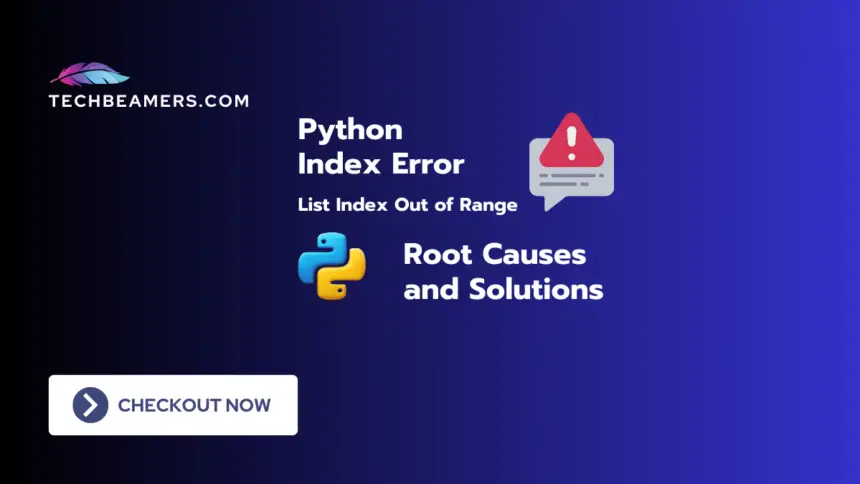An “IndexError: list index out of range” in Python typically occurs when you’re trying to access an index in a list that does not exist. This typically happens when attempting to access an index that is beyond the bounds of the list. In this guide, we’ll explore the causes of this error and discuss various solutions with code snippets.
Python List Index Out of Range – Root Cause and Solution
We can face the IndexError due to different reasons. So, we’ll first try to describe the situation, identify its root cause, and after that discuss the solution. Let’s begin with the most common scenario when you get this error.
Causes of IndexError
The primary reasons for an IndexError in Python typically revolve around attempting to access an index that does not exist in the given list. The three reasons mentioned earlier are common scenarios that lead to this error:
- Incorrect index calculation: Providing an index that is not within the valid range of indices for the list.
- Iterating beyond the length of the list: When using loops or iterators, go beyond the actual length of the list.
- Using a negative index that is out of range: Attempting to access elements using negative indices when they are not supported by the list.
While these are the main causes, there can be variations or combinations of these reasons that lead to an IndexError. It’s essential to carefully review code that involves list indexing, especially when dealing with dynamic data or user inputs, to prevent such errors. Additionally, the proposed solutions in the previous responses aim to address these common causes and provide ways to handle or prevent the IndexError.
Illustrate the Problem and Define a Solution
Let’s start by demonstrating the error with a simple code snippet:
seq = [10, 20, 30, 40, 50]
index_to_access = 10 # Index that is out of range
try:
value = seq[index_to_access]
print(value)
except IndexError as e:
print(f"Error: {e}")The above code throws the error list index out of range. You can follow any of the three approaches to fix.
a. Check Index Before Accessing
One common approach is to check whether the index is within the valid range before accessing the list element.
index_to_access = 10
if 0 <= index_to_access < len(seq):
value = seq[index_to_access]
print(value)
else:
print(f"Index {index_to_access} is out of range.")Pros: Prevents the error by explicitly checking index validity.
Cons: Requires additional conditional statements, and the check may still be prone to errors if not implemented consistently.
b. Using try-except Block
Wrap the list access in a try-except block to catch the IndexError.
index_to_access = 10
try:
value = seq[index_to_access]
print(value)
except IndexError as e:
print(f"Error: {e}")Pros: Provides a way to gracefully handle the error without crashing the program.
Cons: Might mask other potential issues if not used carefully.
c. Using slicing
Slicing allows you to extract a portion of the list without raising an index error.
index_to_access = 10
value = seq[index_to_access:index_to_access+1]
if value:
print(value[0])
else:
print(f"Index {index_to_access} is out of range.")Pros: Returns an empty list instead of throwing an error.
Cons: Requires additional conditional statements and may not be suitable for all use cases.
More List Index Out-of-Range Examples
Let’s go through some more examples where an IndexError occurs due to different reasons:
1. Example with Incorrect Index Calculation
seq = [10, 20, 30, 40, 50]
# Incorrect index calculation
target_index = len(seq) # This will result in IndexError
try:
value = seq[target_index]
print(value)
except IndexError as e:
print(f"Error: {e}")In this example, index_to_access is set to the length of the list, which is out of the valid range of indices. Running this code will result in an IndexError.
Solution: Check the Index Before Accessing
To prevent this error, you can explicitly check whether the index is within the valid range before accessing the list element:
seq = [10, 20, 30, 40, 50]
# Correct index calculation check
target_index = len(seq)
if 0 <= target_index < len(seq):
value = seq[target_index]
print(value)
else:
print(f"Index {target_index} is out of range.")Pros: Prevents the error by explicitly checking index validity.
Cons: Requires additional conditional statements, and the check may still be prone to errors if not implemented consistently.
The updated code checks whether the index is within the valid range before attempting to access the list element, avoiding the IndexError.
Now, consider an example where an IndexError occurs due to iterating beyond the length of the list:
2. Example of Iterating Beyond the Length of the List
seq = [5, 10, 15, 20, 25]
# Incorrect iteration beyond the length of the list
for ele in range(len(seq) + 1): # This will result in IndexError
print(seq[ele])In this example, the loop iterates one more time than the length of the list, leading to an attempt to access an index that does not exist.
Solution: Proper Loop Boundaries
To prevent this error, ensure that the loop iterates only up to the valid range of indices in the list:
seq = [5, 10, 15, 20, 25]
# Correct iteration within the length of the list
for ele in range(len(seq)):
print(seq[ele])Pros: Ensures that the loop iterates within the valid range of indices.
Cons: Requires careful consideration of loop boundaries to avoid errors.
The code after the fix ensures that the loop iterates only up to the valid range of indices, preventing the IndexError that would occur when attempting to access an index beyond the length of the list.
Let’s take an example where an IndexError occurs due to using a negative index that is out of range:
Example of Using a Negative Index That Is Out of Range
seq = [5, 10, 15, 20, 25]
# Incorrect usage of a negative index that is out of range
target_index = -6 # This will result in IndexError
try:
value = seq[target_index]
print(value)
except IndexError as e:
print(f"Error: {e}")In this example, the attempt is made to access an element using a negative index that goes beyond the valid range of negative indices for the list.
Solution: Valid Negative Indices
To prevent this error, ensure that you use negative indices within the valid range supported by the list:
seq = [5, 10, 15, 20, 25]
# Correct usage of a negative index within the valid range
target_index = -len(seq)
try:
value = seq[target_index]
print(value)
except IndexError as e:
print(f"Error: {e}")Pros: Ensures that the negative index is within the valid range.
Cons: Requires careful calculation of the negative index to avoid errors.
This corrected code ensures that the negative index is within the valid range supported by the list, preventing the IndexError.
Conclusion
Handling IndexError, list index out of range involves a combination of careful index management and appropriate error-handling mechanisms. The choice of approach depends on the specific requirements and context of your code. Always validate inputs, use clear and meaningful indices, and implement error-handling strategies to build robust and reliable Python programs.
By carefully examining your code and considering the mentioned points, you should be able to identify and resolve the “IndexError: list index out of range” issue in your Python program.
Happy Coding,
Team TechBeamers









